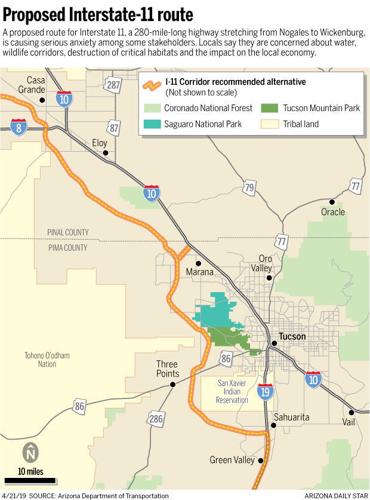Frank Staub’s photography experiences have taken him to Thailand, Cuba and Nicaragua, but his latest and possibly most important project has kept him grounded in the Tucson area.
Staub, a freelance photographer and writer, began his photo project “Here Today” in September to capture the surrounding plants, animals, people and homes that may be impacted by the proposed Interstate 11, a proposed 280-mile highway from Nogales to Wickenburg that would slice through the valley west of the Tucson Mountains.
“I was like a lot of residents in Picture Rocks and Avra Valley, I was very alarmed when I heard that an interstate might be built through our area and the increased traffic and development and habitat destruction was very troubling,” Staub said.
Staub, who lives just outside of Tucson, decided to use his skills to generate more awareness on construction that could occur close to home. He used the Arizona Department of Transportation’s map of a 2,000-foot-wide corridor where the highway could end up to find subjects for his project.
“I wanted to do something about it, and since my talent is in photography, I thought I would try to document what’s there in the path of the proposed interstate now, in hopes of generating sympathy among people who look at the pictures, focus on what would be lost and maybe generate more interest in opposing it,” he said.
Since September, Staub has gotten two households to speak to him and agree to be photographed, in addition to the plants and landscapes he’s already captured.
He’s photographed people like Helen and Eric Mellen outside the home they constructed in the 1990s.
The Mellens said they are worried about potential changes to the surrounding area.
“They have a lot of money and blood, sweat and toil invested into their property and it would be heartbreaking for them to lose it,” Staub said. “There’s a lot of people in the same situation who I haven’t photographed yet.”
Other I-11 opponents
Staub joins other people and organizations opposed to the state’s plans, like the Coalition for Sonoran Desert Protection, which believes a road through Avra Valley would be devastating to the environment. The coalition’s hopes remain in alternatives, such as widening I-10 to increase vehicle capacity.
The Tucson City Council voted to oppose the project, partly because the planned route runs west of the city and through Avra Valley.
But supporters, including Arizona Gov. Doug Ducey, tout the potential economic impacts for the state. But I-11 may cost anywhere from $3.1 billion to $7.3 billion, according to Arizona Daily Star archives.
Ducey said he believes I-11 could be a great international highway, facilitating trade between Canada, Mexico, and the United States and Canada.
Before the project moves forward, a more in-depth environmental impact study would be ordered after the final Tier 1 study is finished sometime in 2020. A Tier 2 study would narrow the preliminary 2,000-foot-wide corridor to 400 feet, with other specific design details.
In the meantime, Staub is planning for the long haul with his newest project.
“I anticipate this being a really long-term project because everybody says that if the interstate does happen, it won’t be for many years and the decision will probably be years away,” said Staub.
“I appreciate the rural character of Picture Rocks and Avra Valley and a lot of people are concerned that it might be destroyed if the interstate is built.”
Down the Road
Moore Road and La Cañada roundabout to open: On Friday afternoon, Oro Valley officials will open a new roundabout at North La Cañada Drive and West Moore Road for about 9,000 motorists a day.
Instead of a four-way stop, motorists using the outside lane will be forced to make an immediate right.
And drivers using the inside lane will go in and out of the roundabout without crossing traffic.








